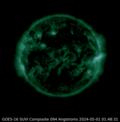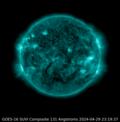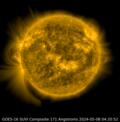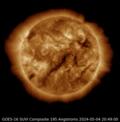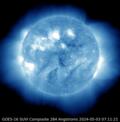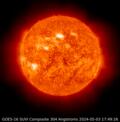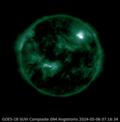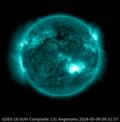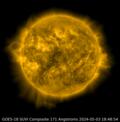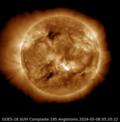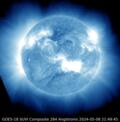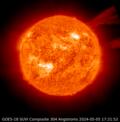Live data from the Geostationary Operational Environmental Satellite(s) (GOES)
Measured by the GOES satellites (current satellite(s): GOES-16/GOES-18). Spikes are considered significant when they rise above the “M” (10-5W/m2) level. The plot shows the solar X-ray output in the 1-8Å (0.1-0.8 nm) and 0.5-4.0Å (0.05-0.4 nm) passbands.
Current 5-minute averaged integral proton flux. At the moment the levels are measured by the SWPC GOES-16 or GOES-18 satellite. SWPC`s proton event threshold is 10 protons/cm2s-1sr-1 at ≥10 MeV.
Current 5-minute averaged integral electron flux. The plot shows flux with energies ≥2 MeV (GOES-16/GOES-18). The data in this plot is invalid during a significant proton event because of sensor contamination at the GOES spacecraft.
Current 1-minute averaged parallel component of the magnetic field. Measured in nanoTeslas (nT) at GOES-16/GOES-18. The GOES spacecraft use hydrazine arcjet thrusters for periodic orbital maneuvers to maintain the desired geostationary location. During arcjet operation, the magnetometer measurements are corrupted by ~20 nT, which is significant relative to the typical 100 nT geomagnetic field magnitude at geostationary orbit.
GOES-R SUVI
The Solar Ultraviolet Imager (SUVI) is a telescope that monitors the sun in the extreme ultraviolet wavelength range. By observing the sun, SUVI is able to compile full disk solar images around the clock. It replaces the GOES Solar X-ray Imager (SXI) instrument and represents a change in both spectral coverage and spatial resolution over SXI.
—
Additional data
The Estimated 3-hour Planetary K index is derived at the NOAA SWPC using data from ground-based magnetometers in Boulder (Colorado), Chambon la Foret (France), Fredericksburg (Virginia), Fresno (California), Hartland (UK), Newport (Washington), Sitka (Alaska) and Jeju (Korea). Kp indices of 5 or greater indicate storm-level geomagnetic activity.
Conditions in the D region of the ionosphere have a dramatic effect on high frequency (HF) communications and low frequency (LF) navigation systems. The global D Region Absorption Predictions (D-RAP) depicts the D region at high latitudes where it is driven by particles as well as low latitudes, where photons cause the prompt changes.
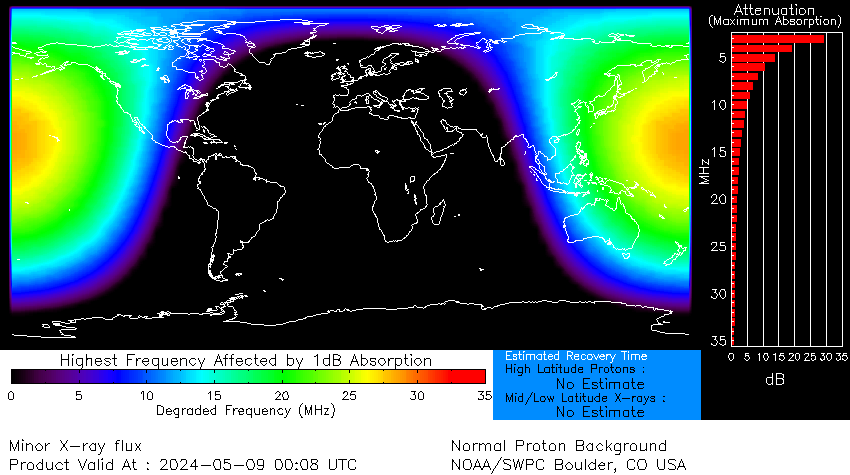
1dB ABS | 5MHz | 10MHz | 15MHz | 20MHz | 25MHz | 30MHz
—
Strongest X-ray solar flares recorded -------------------------------------------- RANK DATE CLASS -------------------------------------------- 1 04-11-2003 X28+* 2 02-04-2001 X20.0 2 16-08-1989 X20.0 3 28-10-2003 X17.2 4 07-09-2005 X17.0 5 06-03-1989 X15.0 5 11-07-1978 X15.0 6 15-04-2001 X14.4 7 24-04-1984 X13.0 7 19-10-1989 X13.0 8 15-12-1982 X12.9 9 06-06-1982 X12.0 9 01-06-1991 X12.0 9 04-06-1991 X12.0 9 06-06-1991 X12.0 9 11-06-1991 X12.0 9 15-06-1991 X12.0 10 17-12-1982 X10.1 10 20-05-1984 X10.1 11 29-10-2003 X10.0 11 25-01-1991 X10.0 11 09-06-1991 X10.0 12 09-07-1982 X9.8 12 29-09-1989 X9.8 13 22-03-1991 X9.4 13 06-11-1997 X9.4 14 24-05-1990 X9.3 14 06-09-2017 X9.3 15 05-12-2006 X9.0 15 06-11-1980 X9.0 15 02-11-1992 X9.0 --------------------------------------------
* Taking a different route, researchers from the University of Otago used radio wave-based measurements of the x-rays’ effects on the Earth’s upper atmosphere to revise the flare’s size from a merely huge X28 to a “whopping” X45, say researchers Neil Thomson, Craig Rodger, and Richard Dowden.
Courtesy of NOAA/SWPC.

